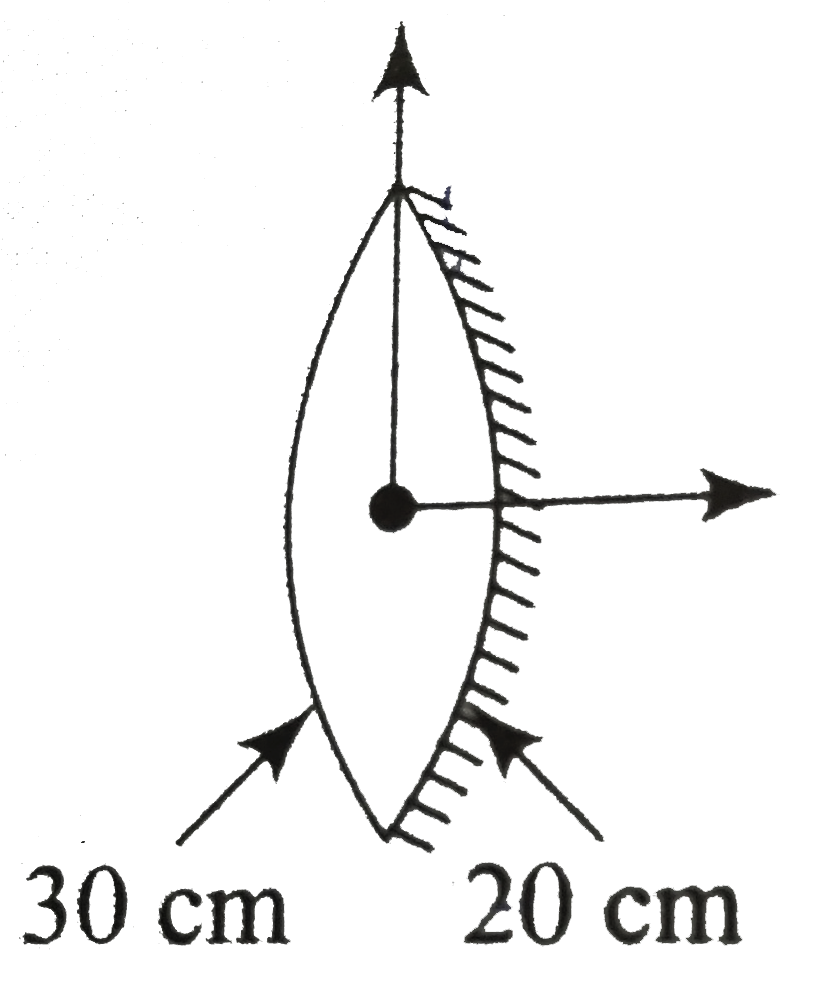Two plano concave lenses of glass of refractive index 1.5 have radii of curvature 20 cm and 30 cm respectively. They are placed in contact with the curved surface towards each other and the space between them is filled with a liquid of refractive index 5/2. The focal length of the combination is (in cm)
6
−92
108
12
The correct Answer is:D
To solve the problem of finding the focal length of the combination of two plano-concave lenses in contact, we will follow these steps:
Step 1: Identify the parameters of the lenses
- Lens 1 (L1): Plano-concave lens with:
- Refractive index (n1) = 1.5 (glass)
- Radius of curvature (R1) = ∞ (flat surface)
- Radius of curvature (R2) = -20 cm (concave surface, negative because it is on the left)
- Lens 2 (L2): Plano-concave lens with:
- Refractive index (n2) = 1.5 (glass)
- Radius of curvature (R1) = -30 cm (concave surface, negative)
- Radius of curvature (R2) = ∞ (flat surface)
- Liquid between the lenses:
- Refractive index (n_liquid) = 5/2
Step 2: Calculate the focal length of the first lens (L1)
Using the lens maker's formula:
1f1=(n1−1)(1R1−1R2)
Substituting the values:
1f1=(1.5−1)(1∞−1−20)
1f1=0.5(0+120)=0.5⋅120=140
Thus,
f1=−40 cm
Step 3: Calculate the focal length of the second lens (L2)
Using the lens maker's formula for the second lens:
1f2=(nliquid−1)(1R1−1R2)
Substituting the values:
1f2=(52−1)(120−1−30)
Calculating:
1f2=32(120+130)
Finding a common denominator (60):
1f2=32(360+260)=32⋅560=15120=18
Thus,
f2=8 cm
Step 4: Calculate the focal length of the combination
Now, we need to find the overall focal length of the combination of the two lenses:
1f=1f1+1f2
Substituting the values:
1f=1−40+18
Finding a common denominator (40):
1f=−140+540=440=110
Thus,
f=10 cm
Final Answer
The focal length of the combination is 10 cm.
---
- Lens 1 (L1): Plano-concave lens with:
- Refractive index (n1) = 1.5 (glass)
- Radius of curvature (R1) = ∞ (flat surface)
- Radius of curvature (R2) = -20 cm (concave surface, negative because it is on the left)
- Refractive index (n2) = 1.5 (glass)
- Radius of curvature (R1) = -30 cm (concave surface, negative)
- Radius of curvature (R2) = ∞ (flat surface)
- Refractive index (n_liquid) = 5/2
Using the lens maker's formula:
1f1=(n1−1)(1R1−1R2)
Substituting the values:
1f1=(1.5−1)(1∞−1−20)
1f1=0.5(0+120)=0.5⋅120=140
Thus,
f1=−40 cm
Using the lens maker's formula for the second lens:
1f2=(nliquid−1)(1R1−1R2)
Substituting the values:
1f2=(52−1)(120−1−30)
Calculating:
1f2=32(120+130)
Finding a common denominator (60):
1f2=32(360+260)=32⋅560=15120=18
Thus,
f2=8 cm
Now, we need to find the overall focal length of the combination of the two lenses:
1f=1f1+1f2
Substituting the values:
1f=1−40+18
Finding a common denominator (40):
1f=−140+540=440=110
Thus,
f=10 cm
The focal length of the combination is 10 cm.
Topper's Solved these Questions
- BOOK - AAKASH SERIESCHAPTER - GEOMETRICAL OPTICSEXERCISE - LECTURE SHEET (EXERCISE III LEVEL -II (ADVAMCED) MORE THAN ONE CORRECT TYPE QUESTIONS)1videos
GEOMETRICAL OPTICS
- BOOK - AAKASH SERIESCHAPTER - GEOMETRICAL OPTICSEXERCISE - LECTURE SHEET (EXERCISE III LEVEL -II (ADVAMCED) LINKED COMPREHENSION TYPE QUESTIONS)3videos
GEOMETRICAL OPTICS
- BOOK - AAKASH SERIESCHAPTER - GEOMETRICAL OPTICSEXERCISE - LECTURE SHEET (EXERCISE III LEVEL -I (MAIN) STRAIGHT OBJECTIVE TYPE QUESTIONS)7videos
GEOMETRICAL OPTICS
- BOOK - AAKASH SERIESCHAPTER - ELEMENTS OF VECTORSEXERCISE - QUESTIONS FOR DESCRIPTIVE ANSWERS10videos
ELEMENTS OF VECTORS
- BOOK - AAKASH SERIESCHAPTER - LAWS OF MOTIONEXERCISE - PRACTICE EXERCISE106videos
LAWS OF MOTION
Similar Questions
Two plano-concave lenses of glass of refractive index 1.5 have radii of curvature of 20 and 30 cm. They are placed in contact with curved surface towards each other and the space between them is filled with a liquid of refractive index 43, find the focal length of the system.
View SolutionTwo plano-concave lenses of glass of refractive 1.5 have radii of curvature of 20 and 30 cm. They are placed in contact with curved surface towards each other and the space between yhem is filled with a liquid of refractive index 2/3. Find the focal length of the system.
View SolutionTwo identical thin planoconvex glass lenses (refractive index 1.5) each having radius of curvature of 20cm are placed with their convex surfaces in contact at the centre. The intervening space is filled with oil of refractive index 1.7. The focal length of the combination is
View SolutionTwo identical thin planoconvex glass lenses (refractive index 1.5) each having radius of curvature of 20 cm are placed with their convex sufaces in contact at the centre. The intervening space is filled with oil of refractive index 1.7 The focal length of the combination is
View SolutionA plano convex lens is made of glass of refractive index 1.5. The radius of curvature of its convex surface is R. Its focal length is
View SolutionTwo concave lenses L1andL2 are kept in contact with each other. If the space between the two lenses is filled with a material of smaller refractive index, the magnitude of the focal length of the combination
View SolutionA plano-concave lens is made of glass of refractive index 1.5 and the radius of curvature of its curved face is 100 cm. What is the power of the lens?
View SolutionA plano-convex lens has refractive index 1.6 and radius of curvature 60 cm. What is the focal length of the lens?
View SolutionA concavo-convex lens is made of glass of refractive index 1.5. The radii of curvature of its two surfaces are 30cm and 50cm. Its focal length when placed in a liquid of refractive index 1.4 is
View SolutionA biconvex lens is made of glass with refractive index 1.5 and has radii of curvature 20 cm and 30 cm. If the 20 cm surface is silvered, what is the effective focal length of the mirror formed?
 View Solution
View Solution
